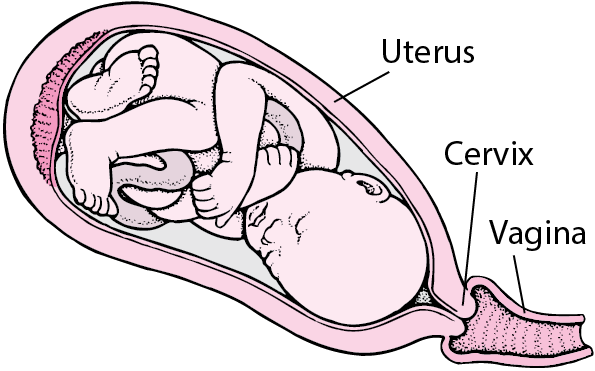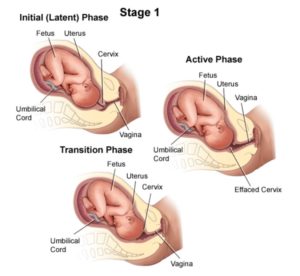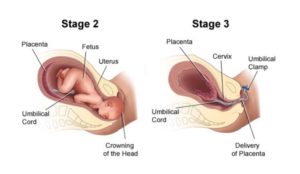
Table of Contents
Labor During Pregnancy
- Labor during pregnancy is a series of continuous, progressive contractions of the uterus that help the cervix dilate (open) and efface (thin) so that the fetus can come outside.
- Labor during pregnancy is a set of actions that occur in a woman’s genital organ in an endeavor to push the fetus through the vagina into the outside world.
- Labor during pregnancy is defined as the beginning of painful, regular contractions during pregnancy at a rate of more than one every ten minutes.
- In other words, labor during pregnancy is the method by which the fetus leaves the uterus.
- It usually starts two weeks before or after the estimated date of delivery (EDD).
- It also includes increasing cervical effacement and dilatation and descent of the presenting portion.
- Labor is mainly divided into three stages:
- Dilation and effacement of the cervix
- Pushing
- Delivery of the placenta
- Preterm labor is the labor that occurs before 37 weeks of gestation/pregnancy.
Signs of Labor During Pregnancy
- Backache
- An urge to use the restroom brought on by your baby’s head pressing against your bowels
- Contractions or tightening: contraction of the uterus at an interval of less than 10 minutes
- A “show”: when the small amount of mucus from your cervix comes away
- Rupture of the amniotic sac, also called as ‘breaking of water’ or ‘water breaking’
Stages of Labor During Pregnancy
1. First stage
- The first stage of labor is the dilation of the cervix.
- Regular uterine contractions signal the start of the first stage, which lasts until full cervical dilatation at 10 cm.
- It is comprised of:
- Latent phase (0-3 cm dilatation)
- Active phase (4–10 cm dilatation)
- The latent phase starts with light, erratic uterine contractions that soften and shorten the cervix. The contractions gradually get stronger and more rhythmic.
- The active phase follows, which is marked by fast cervical dilation and descent of the presenting fetal portion. It typically starts at around 3–4 cm of cervical dilatation.

2. Second stage
- The second stage of labor is ‘pushing’.
- The second stage begins with complete cervical dilation and finishes with the fetus being delivered.
- It is the stage of the baby’s descent and delivery.
- It usually requires two hours.
- It should be regarded as prolonged if it takes more than 2 hours.

3. Third stage
- The third stage of labor pain is delivery of the placenta.
- The interval between the delivery of the fetus and the delivery of the placenta and fetal membranes is known as the third stage of labor.
- It can last up to 30 minutes, even though the delivery of the placenta typically takes less than that.
Ways to Induce Labor During Pregnancy
- For a vaginal birth, labor induction involves making the uterus contract during pregnancy before it naturally starts to labor.
- Unless there is any problem, it is not induced before 39 weeks of pregnancy.
Possibilities for Naturally Inducing Labor During Pregnancy
These are a few methods to try in order to naturally start labor. However, these methods are not scientifically established. They are:
- Prostaglandins, hormone-like molecules that are similar to the drugs used to induce labor, are released during sex.
- Check to see if your water hasn’t burst and get the all-clear from your doctor or midwife.
- Acupuncture
- Other approaches include taking long walks for exercise, eating hot foods, using castor oil, etc.
Possibilities for Inducing Labor at Hospital
- Prostaglandins are commonly used as a vaginal cream or as pills to begin the labor-inducing process. This alone will sometimes trigger contractions.
- Giving an intravenous (IV) infusion of oxytocin (a hormone produced by the pituitary gland that stimulates contractions) or a similar drug.
- Artificially rupturing the amniotic sac.
- Pitocin, a synthetic version of the hormone oxytocin, is the next step if prostaglandins doesn’t start labor
- Pitocin causes the uterus to contract. It should be administered only when the cervix is open and ready for labor.
Reason for Induction of Labor Before the Delivery Date
- One to two weeks have passed since the due date and labor has not yet begun (post-term pregnancy).
- Mother or fetus is at risk due to some complication/s.
- When the water breaks and labor doesn’t start (pre-labor rupture of membranes).
- Infection in the uterus (chorioamnionitis).
- Fetus is diagnosed with poor growth
- When the predicted weight of an infant is under the gestational age 10th percentile (fetal growth restriction).
- When the infant is not sufficiently covered by amniotic fluid (oligohydramnios).
- Possibly when diabetes already existing prior to conception or when diabetes develops during pregnancy (gestational diabetes).
- Mother has preeclampsia, eclampsia or high blood pressure:
- Having high blood pressure while pregnant and showing symptoms of harm to another organ system (preeclampsia).
- Having high blood pressure prior to becoming pregnant, getting chronic high blood pressure prior to 20 weeks of pregnancy, or doing so after 20 weeks of pregnancy (gestational hypertension).
Pain Management During Labor
Medicated pain management during labor
- Sedation and analgesia: the use of drugs like sedatives and opiates to make people feel less pain
- Anesthesia: the process of using drugs to either partially or completely obstruct all sensation in a bodily part. It may be local, regional, or universal.
Non-medicated pain management during labor
- Relaxation of the muscles
- It has been demonstrated that one-on-one care during labor from a midwife and a supportive birth partner can minimize the requirement for analgesics.
- The woman’s ability to handle her pain may be aided by relaxation and breathing exercises.
- Homeopathy, acupuncture, and hypnosis are occasionally used, but their application has not been linked to a meaningful reduction in pain scores or a decreased demand for conventional analgesics.
- During the first stage of labor, relaxation in warm water frequently induces a feeling of wellbeing and enables women to tolerate pain considerably better.
- The idea behind transcutaneous electrical nerve stimulation (TENS) is to block pain fibers in the spinal cord’s posterior ganglia by stimulating tiny afferent fibers.
Relaxation Technique During Labor
1. Method of deep breathing and relaxing
- breathing method
- relaxation method
- counted breaths
- breathe in via the nose and out through the mouth.
2. Method for relaxation
- Massages
- Hydrotherapy: water therapy
- Meditation or focused thinking
- calming surroundings
- Reflexology
- Having relaxing ideas
References and For More Information
https://www.hopkinsmedicine.org/health/wellness-and-prevention/labor
https://www.mayoclinic.org/healthy-lifestyle/labor-and-delivery/in-depth/stages-of-labor/art-20046545
https://www.betterhealth.vic.gov.au/health/healthyliving/pregnancy-labour
https://my.clevelandclinic.org/health/articles/9676-labor-delivery
https://www.webmd.com/baby/labor-signs
https://www.manipalhospitals.com/mangalore/blog/pain-relief-during-labour
https://www.healthline.com/health/pregnancy/labor-and-delivery
https://www.medicinenet.com/how_long_does_labor_last_for_first-time_moms/article.htm
https://www.verywellhealth.com/stages-of-labor-5176472